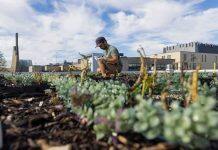A team of Australian and German researchers has discovered a novel pathway that plants can use to save water and improve their drought tolerance.


The research published in Nature Communications shows that the molecule GABA (gamma-aminobutyric acid), most commonly associated with relaxation in animals, can control the size of the pores on plant leaves to minimise water loss.
Matthew Gilliham, Director of the Waite Research Institute at the University of Adelaide, who led the research team, said they found: “GABA minimised pore openings in a range of crops such as barley, broad bean and soybean, and in lab plants that produce more GABA than normal. This led to the lab plants using less water from the soil and surviving longer in the drought experiments.”
“We found plants that produce lots of GABA reduce how much their pores open, thereby taking a smaller breath and reducing water loss.”
– Professor Matthew Gilliham
In an earlier study , members of the team found that GABA – known as a nerve signal in animals – could act as plant GABA receptors. This led to renewed speculation that GABA could be a signal in plants as well as in animals.
Lead author on the study, Dr Bo Xu, a Postdoctoral Researcher at the Australian Research Council (ARC) Centre of Excellence in Plant Energy Biology adds: “Both plants and animals produce GABA and they put it to different uses. Plants don’t have nerves, instead they appear to use GABA to match their energy levels with their response to the environment.”
“GABA doesn’t close pores on leaves like other stress signals, it acts in a different way – how much a plant accumulates GABA when it is stressed determines how much it applies the brake pedal to reduce the pore opening the following morning, and water loss that day – like a stress memory of the day before.”
Professor Rainer Hedrich at the University of Würzburg, a pioneer in studying how plants regulate water loss, led the German component of the study.
“I’ve been studying how plants regulate their stomatal pores for over 35 years. To find a completely new and unexpected way that they are regulated has certainly been one of our most surprising discoveries. I look forward to seeing how this translates out in the field.”
The team recently received a new grant from the Australian Federal Government to partner with researchers at the University of Cambridge, UK, and are looking for new PhD students to join the team to discover new components of the signalling pathway and to trial its impact in crops.








































